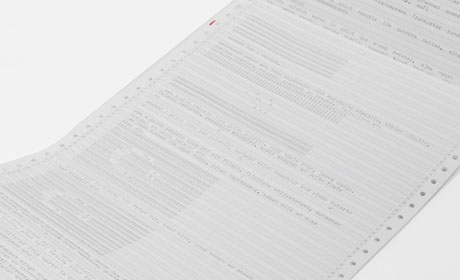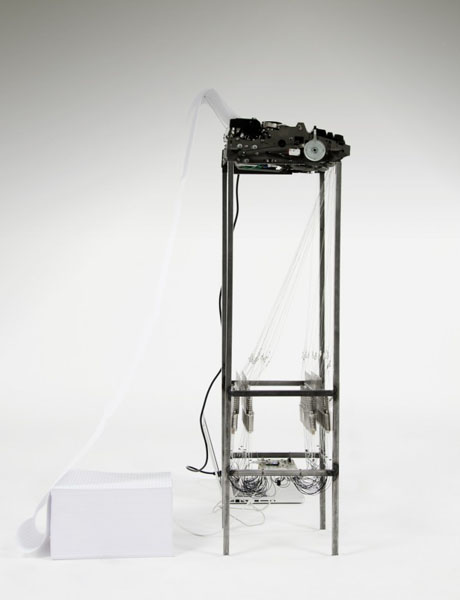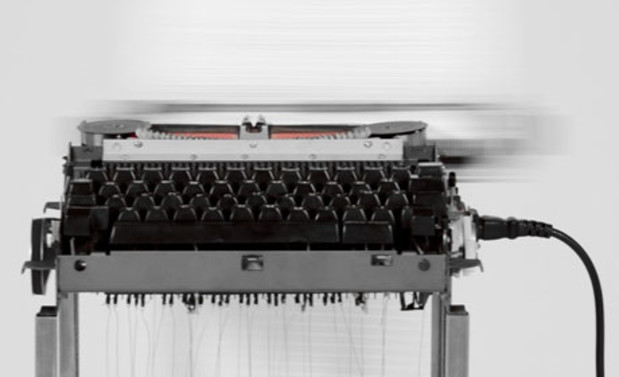In an isolated corner of a gallery an automated typewriter prints names onto an endless sheet of paper. The methodical clicking noise of the keys is only interrupted by a sharp ping each time a line is finished.
The installation is disconcerting, not least because the machine is programmed to print the names of, and stories behind, every journalist killed for the past 20 years.
On Journalism #2 Typewriter is Julian Koschwitz's latest project.
Koschwitz, an interactive art director who teaches at the Free University of Bozen-Bolzano in Italy, hopes that his work will remind the viewer of the risks journalists take to provide news to consumers in an increasingly fast-paced and competitive environment dominated by social media.
"When we look at digital news what we see is technology, not the journalists who provide the news.
"Right now we get these jumpy 'Facebook status' updates of news in a second. We are like goldfish in a bowl having a memory of four or five seconds. But I think it is necessary for journalists to give readers a bit more contextual information.We are like goldfish in a bowl having a memory of four or five seconds. But I think it is necessary for journalists to give readers a bit more contextual informationJulian Koschwitz
"This project is to remember the journalists who are the interfaces. It makes us aware of who is providing the news, who is risking their lives to give us a tweet."
Koschwitz says the switch from print journalism to online is making consumers focus too much on the instant content of news stories, and forget about the means of acquiring the information.
The 30-year-old typewriter, chosen because it is an iconic and disused symbol of journalism, is hooked up to generative software which produces words and images based on data from the Committee to Protect Journalists (CPJ) and other web searches. The installation is held in an art gallery in Bozen-Bolzano.
What appears on the paper are the names and other information about the journalists killed, including images such as flags of the countries they are from, which are distorted depending on the levels of press freedom in that country.

Koschwitz believes that the visual dimension of his work will raise awareness in a way that stories and lists on a website cannot.
"It is important that it does not look like some pie chart on an annual report.
"Even if you just have a brief look at it, you get an idea of some sort of composition which you can compare with reading a headline.
"If you have something which moves and becomes interactive, then it gives you more to think about, you can feel yourself in the subject, rather than if you just read about what happened and you have this one dimension of text.
"It gives a chance to scroll through the history of news in relation to those who have had to give their lives because they were in a very unfortunate situation.
"That you get someone to take time to look at it because it visually pleases him or her – and visually pleasing can be disturbing – is necessary."
It is not just the 918 – and counting – names being printed onto the equivalent of 3,500 sheets of A4 paper, giving the sensation of a never-ending story, that leads to the uncomfortable viewing. The apparent lack of human input and interaction with the piece gives it an isolated, cold, inhumane quality.
"It's supposed to have this very cold, mechanical, rigid but aesthetically clean appearance that doesn't give you any comfort, because the subject is not comfortable."
But what packs a punch is that On Journalism #2 is not programmed to stop. Koscwitz says that it will only stop if it runs out of ink, paper or somebody pulls the plug.
And he estimates that it would take five months before any information is repeated – a testimony to the extortionate number of journalists killed since 1992.

Free daily newsletter
If you like our news and feature articles, you can sign up to receive our free daily (Mon-Fri) email newsletter (mobile friendly).










